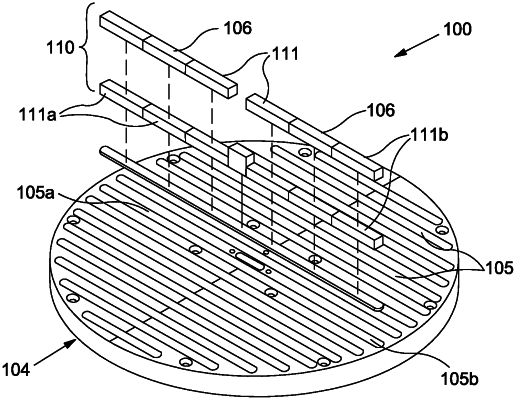| CPC C23C 14/50 (2013.01) [C23C 14/345 (2013.01); C23C 14/3485 (2013.01); C23C 14/35 (2013.01); C23C 14/351 (2013.01); C23C 14/505 (2013.01); H01J 37/32715 (2013.01); H01J 37/3405 (2013.01); H01J 37/3452 (2013.01); H01J 37/3455 (2013.01); H01J 37/3467 (2013.01); C23C 14/542 (2013.01)] | 6 Claims |

|
1. A magnet assembly within a platen that supports a substrate for steering ions used in formation of a material layer upon the substrate during a pulsed DC physical vapour deposition process, the magnet assembly configured to be disposed within a recess of the platen, the magnet assembly comprising:
a magnetic field generating arrangement for generating a magnetic field proximate and below the substrate,
means for rotating the magnetic field generating arrangement about an axis of rotation, relative to the substrate,
wherein the magnetic field generating arrangement comprises a plurality of magnets configured to an array which extends around the axis of rotation, wherein the array of magnets are configured to generate a varying magnetic field strength along a radial direction relative to the axis of rotation, and wherein the array comprises a plurality of linear sub-arrays arranged in a parallel configuration and a stacked configuration,
a cassette, wherein the plurality of magnets are disposed within the cassette having a plurality of recesses adapted to receive the linear sub-arrays, wherein the recesses are defined in an outer surface of the cassette, wherein the substrate is disposed above the cassette, wherein the linear sub-arrays extend parallel with a diameter of the cassette, wherein the magnets within the recesses are configured in the stacked configuration, wherein the array of magnets with the stacked configuration is configured such that the varying magnetic field strength is greater proximate a periphery of the recesses in the cassette than a centre of the cassette, wherein at least one of the recesses has a first and second recess portion on either side of the centre of the cassette, wherein at least two of the recesses extend from one end of the periphery to the other end of the periphery, and wherein all the recesses are parallel to each other, and
at least one non-magnetic spacer for spacing the magnets within at least one of the recesses.
|